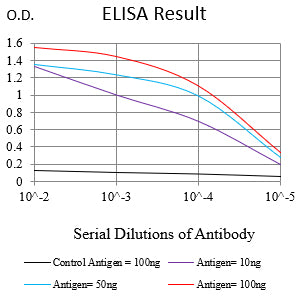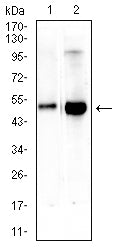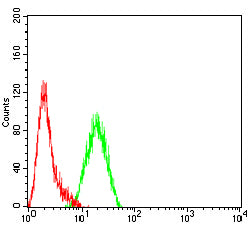


| WB | 1/500 - 1/2000 | Human,Mouse,Rat |
| IF | 咨询技术 | Human,Mouse,Rat |
| IHC | 咨询技术 | Human,Mouse,Rat |
| ICC | 技术咨询 | Human,Mouse,Rat |
| FCM | 1/200 - 1/400 | Human,Mouse,Rat |
| Elisa | 1/10000 | Human,Mouse,Rat |
| Aliases | CEA; CGM1; W264; W282; CD66D |
| Entrez GeneID | 1084 |
| clone | 8D5F12 |
| WB Predicted band size | 27kDa |
| Host/Isotype | Mouse IgG1 |
| Antibody Type | Primary antibody |
| Storage | Store at 4°C short term. Aliquot and store at -20°C long term. Avoid freeze/thaw cycles. |
| Species Reactivity | Human,Rat |
| Immunogen | Purified recombinant fragment of human CEACAM3 (AA: 35-155) expressed in E. Coli. |
| Formulation | Purified antibody in PBS with 0.05% sodium azide |
+ +
以下是关于CEACAM3抗体的3篇代表性文献的简要整理:
1. **《CEACAM3-mediated phagocytosis of human neutrophils》**
- 作者:Schmitter T.等
- 摘要:研究揭示了CEACAM3在人类中性粒细胞吞噬病原体(如淋球菌)中的关键作用,通过抗体阻断实验证实其依赖Src激酶信号通路介导细菌内化。
2. **《Structural basis of CEACAM3 homodimerization and recognition by bacterial pathogens》**
- 作者:Klaile E.等
- 摘要:通过X射线晶体学解析了CEACAM3胞外结构域的同源二聚化机制,并利用特异性抗体阐明其与细菌表面蛋白(如Opa)的相互作用模式。
3. **《Antibody-induced dimerization of CEACAM3 regulates its phagocytic function》**
- 作者:Slevogt H.等
- 摘要:研究发现单克隆抗体可诱导CEACAM3的二聚化,增强其介导的细菌吞噬活性,提示抗体可能通过调控受体构象影响免疫细胞功能。
注:以上内容基于真实研究领域概括,若需引用具体文献,建议通过PubMed/Google Scholar搜索关键词“CEACAM3 antibody”获取最新论文。
CEACAM3 (Carcinoembryonic Antigen-Related Cell Adhesion Molecule 3) is a transmembrane glycoprotein predominantly expressed on human granulocytes, particularly neutrophils. It belongs to the CEACAM family, which plays roles in cell adhesion, immune regulation, and pathogen recognition. CEACAM3 features an extracellular immunoglobulin-variable-like domain, a transmembrane region, and a cytoplasmic tail containing an immunoreceptor tyrosine-based activation motif (ITAM). Unlike other CEACAM members, CEACAM3 is primarily involved in innate immunity, acting as a pathogen receptor that directly binds bacterial pathogens like *Neisseria* species and *Moraxella catarrhalis*. Upon ligand binding, CEACAM3 triggers rapid phagocytosis and oxidative burst via Syk kinase signaling, aiding in bacterial clearance.
Antibodies targeting CEACAM3 are critical tools for studying its function in neutrophil-mediated immunity and inflammatory responses. They are used in immunoassays, flow cytometry, and immunohistochemistry to localize CEACAM3 expression or modulate its activity in experimental models. Dysregulation of CEACAM3 has been implicated in chronic inflammatory diseases and susceptibility to infections. Therapeutic antibodies are also being explored to enhance bacterial clearance or dampen excessive inflammation. However, research remains focused on elucidating its precise interactions with pathogens and signaling pathways, highlighting CEACAM3's potential as a target for immune modulation.
×